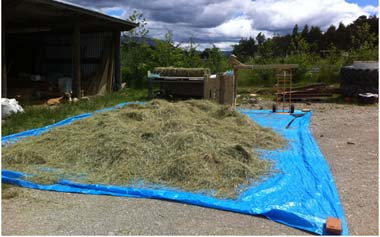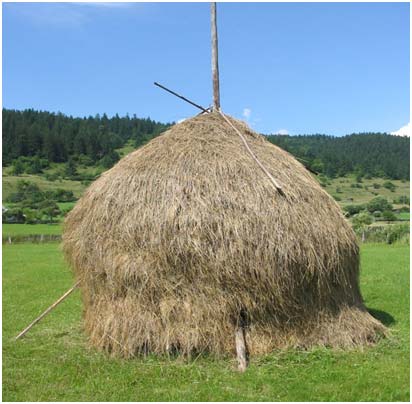 |
|
|
Translate this page in your preferred language:
|
| HAY MAKING : |
| Back |
Hay Making
- Hay is any forage crop cut before it is actually dead ripe and suitably dried for storage.
- It is more nutritious and palatable than straw, because the entire crop is cut at the proper vegetative stage of growth (strictly before maturity) and scientifically desiccated.
- High quality hay is made from fine-stemmed grasses and legumes, harvested at the right stage of growth and dried in such a way as not to lose any of the nutrients.
- It is leafy, pliabale, green in colour and free from mould, weeds, dust and has a pleasant characteristic smell and aroma.
- The preservation and storage of surplus herbage has become an important activity for the balanced feeding of animals and the purpose in making hay is to produce a dried product of high quality.
- Quality is a combination of chemical, physical and biological properties that influence the intake, digestion and utilization of the forages that further determine the growth and productivity of the animals consuming them.
- To produce high quality hay, at least two conditions must be observed viz. good forage must be harvested at a proper stage and it must be dried with minimum loss of nutrients.


Sun drying of hay
Baling of hay for storage

Traditional method of hay making
Quality of the herbage to be made into hay :
- The chemical composition and nutritive value of standing herbage at anyone time is influenced by genetic and environmental factors that are highly interrelated.
- Genetic factors determine the species of plants, the strain within a species, the type of growth and the response to environmental factors.
- Some environmental factors include climate, weather and soil management.
- Because of the extreme variability of plants and of the wide range of environmental conditions, even in a limited geographical area, the chemical compositions (nutritive value) of any plant at the time of cutting is unique and perhaps are not exactly alike for all types of plants.
How to feed low grade roughages economically :
- Good quality hays are better relished by the animals due to their better palatability, and little residues are left.
- But the weather conditions in this state are not only highly variable, but the artificial drying facilities are also highly expensive and thus the quality of hays is not usually good.
- The grasses normally available for hay making are also poor in quality and heavily lignified. Lot of straws and stovers, that are the residues of the crops like wheat, barley, paddy, maize, sorghum and bajra are abundantly available for feeding to the animals during the lean periods and nutritionally these are very poor.
- The low-grade roughages i.e. poor quality hays, paddy straw, maize, sorghum and bajra stalks can be utilized by ruminants more efficiently if they are suitably processed and the protein content is augmented by adding cheaper non-protein-nitrogenous sources and soluble carbohydrates.
The following method is recommended for improving the palatability, intake and utilization of low-grade roughages by the ruminants:
- The grass hays, stovers, stalks and straws should be suitably chaffed to the size of
2.0 to 2.5 cm chops.
- The chaffed materials should be uniformly mixed with urea, mineral mixture and molasses in thefollowing proportions :
• Chaffed material : 100 kg
• Molasses : 10 kg
• Urea : 1 kg
• Mineral mixture : 2 kg
Urea and mineral mixture should be well dissolved in about 10 L of water and then mixed with molasses. This solution should be uniformly sprinkled over the spread chaffed material and the mixing should be done thoroughly to have even distribution of the urea-molasses mixture.
• The mixed feed prepared as above can be fed immediately or can be preserved after proper drying in sun.
Precaution : Urea should be well dissolved in water before mixing with molasses and thereafter uniformly mixed with thechaffed material assuring its uniform distribution in the chaffed material.
|
|
| Back |
|
|
Developed by :
|
Jaspal Singh
(Ex. M.V.Sc Scholar ) |
Dr. Pranav Kumar
(Assistant Professor)
|
Amandeep Singh
(Final Year B.V.Sc & AH student) |
|
|
|
|
|
|
Scroll
|
Division of Veterinary and Animal Husbandry Extension Education
Faculty of Veterinary Sciences and Animal Husbandry, R.S. Pura, SKUAST Jammu |
|



